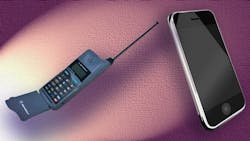This file type includes high-resolution graphics and schematics when applicable.
Does anyone remember pulling out the antenna on your first mobile phone to make a call? Over the past 25 years, antenna design has changed radically for cell phones. While transitioning from 2G to 3G to LTE, we have incrementally and gradually sacrificed as much as 10 dB of link budget in some cases. It’s shocking but true: The network has improved dramatically, so we’ve been able to compromise performance in the handset antenna without much backlash from consumers (Fig. 1).
Multiple factors come into play here:
• The elimination of the extended antenna
• Metal-backed phone cases
• Multi-band antenna requirements, with carrier aggregation, Licensed Authorized Access (LAA), and multiple input, multiple output (MIMO)
• Smaller antenna form factors
• Time-to-market pressure that leaves little time for optimization
Most people didn’t notice the reduction of antenna performance, because government agencies require conducted testing (with a connector at the antenna port), and carriers generally perform testing in a “free space” chamber environment. CTIA certification requires free-space testing, but only under fairly optimal conditions.
Dynamic performance testing with realistic hand-grip fixtures is rarely required by anyone. In fact, testing is often done with hand-grip fixtures using a foam spacer to avoid simulating the poor performance with a true hand. The industry is hiding from the truth: We have been throwing away performance by ignoring real-world conditions.
However, the 25-year trend of throwing away antenna performance is starting to turn in the other direction. We’re starting to see handset OEMs investing in new technology that specifically targets improvements in total radiated power (TRP) and total isotropic sensitivity (TIS). The benefits can be huge.
Diversity
In addition to tuning the main antenna, adding diversity antennas to the terminal can make a big difference. Most smartphones now include 2×2 MIMO for LTE, which prompted adding a second antenna to their designs for LTE frequency bands. According to LTE standards, the second antenna can be used for receiver diversity or for MIMO, depending on which mode is more advantageous with prevailing channel conditions.
Taking this concept one step farther, a few handsets (e.g., the Google Pixel and the Galaxy S7) now use four antennas in key LTE bands to support choices like 4-way receiver diversity and 4×4 MIMO. The gain in throughput is not obvious in a free-space test. However, in the real world, with hands gripping metal-backed phones, the impact of additional antenna options can be significant. Some vendor testing has revealed more than a 60% increase in throughput.
Mobile operators are starting to invest in 4×4 MIMO for some base stations, but it’s clear that this capability will not be implemented everywhere. Therefore, we expect the architecture of the smartphone to include diversity switches that allow for either 4×4-MIMO operation or 4-way receiver diversity, enabling the best possible performance in all situations.
Tuning
Aperture tuning was introduced 10 years ago and has become a standard part of any smartphone that includes multiple bands between 700 and 960 MHz. In most smartphones today, it is implemented as a simple switch that changes the electrical length of the antenna, thus changing its resonant frequency from one band to another. Some handsets use MEMS devices for this purpose.
In addition to frequency tuning, more than 100 smartphone models now include impedance-match tuning, which adapts for the impact of a hand on the phone (Fig. 2). Closed-loop impedance-match tuning can recover more than 4 dB of lost performance in radiated power, which translates directly into user benefits such as:
• Longer battery life: As much as an hour per day longer for typical users.
• More stable data sessions: TDD links tend to be dropped due to uplink limitations. A 4-dB improvement in TRP greatly improves the stability of the LTE link.
• Higher data throughput: Both uplink and downlink benefit from higher signal quality.
Carrier Aggregation
Many people believe that antenna tuning is incompatible with carrier aggregation (CA), especially where CA is implemented for low-low band combinations or high-high band combinations. However, the closed-loop tuning used today can be adapted for different scenarios. Mobile Experts forecasts adoption of impedance-match tuning and possibly aperture tuning, even in the low-low CA case. The modem will need to make some new decisions about what tuning settings are required for a wideband match versus a narrowband match. This is the next natural step in evolution.
Notably, CA can include multiple licensed bands, but also incorporate LAA, 3.5-GHz Citizens Broadband Radio Service (CBRS), and other bands. The algorithm can get pretty complex when combinations of licensed and unlicensed bands are constantly changing.
What’s Coming Next
The industry pattern has started to change. Ten years ago, handset OEMs recognized the inferior performance of some antenna choices they were making, but they were not willing to spend another two dollars per handset to fix the problems. Today, handset OEMs are voluntarily choosing to use tuning solutions. These solutions have been simplified and “systemized” so that the cost is much lower than before. New handsets employ a combination of diversity and tuning to improve everyday performance by 4 dB—and up to 10 dB for some cases.
If the 600-MHz auction results in new spectrum for mobile handsets, we expect all of the problems with antenna performance to get even worse. Lower operating frequencies translate into electrically short antennas—the antenna dimensions are smaller than a wavelength.
Being electrically short causes poor efficiency in general for the antenna, forcing system engineers to rely on a more resonant antenna with more narrowband performance to reduce electrical losses. As the 600-MHz band comes onto the market and CA is required with 700- or 850-MHz bands, we can expect much more sophisticated use of “systemized” tuners that can optimize for multiple bands in a dynamic environment (Fig. 3).
The key lies in considering the antenna as a system, not a component. Handset OEMs are dealing with dozens of bands, and their products are intended to work in countless frequency combinations. The solution to the complexity is smarter antenna tuning.
Modem suppliers that implement advanced closed-loop antenna algorithms will be able to squeeze much more performance out of the handset. This is not a small technical detail, but a major impact—closed-loop tuning can effectively double the handset’s true power. The result will be longer battery life and higher data speed for anybody who holds a phone in their hand. Yes, that means you.
Joe Madden is Principal Analyst at Mobile Experts.






